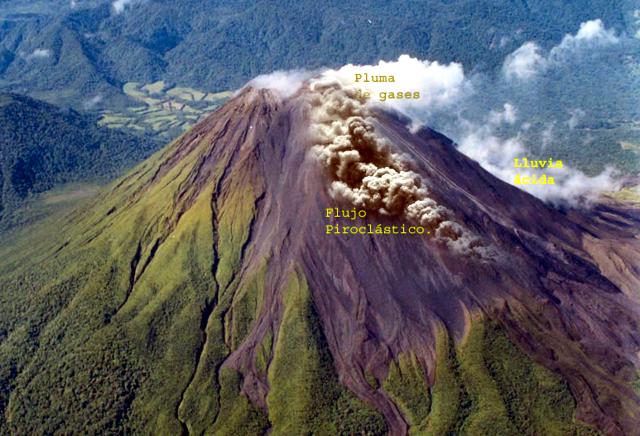Report on Arenal (Costa Rica) — September 2003
Bulletin of the Global Volcanism Network, vol. 28, no. 9 (September 2003)
Managing Editor: Edward Venzke.
Arenal (Costa Rica) Pyroclastic-flow sequence down the N and NE flanks on 5 September
Please cite this report as:
Global Volcanism Program, 2003. Report on Arenal (Costa Rica) (Venzke, E., ed.). Bulletin of the Global Volcanism Network, 28:9. Smithsonian Institution. https://doi.org/10.5479/si.GVP.BGVN200309-345033
Arenal
Costa Rica
10.463°N, 84.703°W; summit elev. 1670 m
All times are local (unless otherwise noted)
On 5 September the Observatorio Vulcanologico y Sismologico de Costa Rica (OVSICORI-UNA) reported that a new sequence of pyroclastic flows started at 1055 that day (figure 98). At least eight signals related to the collapses were recorded within the next two hours by seismographs at the observatory. Material shed from high-elevation accumulations of lava generated the pyroclastic flows, which descended the N and NE flanks down to 800 m elevation; accompanying ash drifted W and NW. No injuries or deaths occurred, and the main effects were limited to within the National Park boundaries. Patches of vegetation at the flow terminations caught on fire. Similar flows have occurred in recent years (e.g. May 1998, August 2000, and March 2001) affecting the summit and upper areas of the active cone C. No explosive eruptions or extraordinary seismic activity were associated with these latest pyroclastic flows.
 |
Figure 98. Photograph of a pyroclastic flow descending the NE flank of Arenal, 5 September 2003. Courtesy of OVSICORI-UNA. |
Unreported observations from 2002. At the time of the last summary report about Arenal (BGVN 28:08), information from January, February, and April 2002 was not available; those OVSICORI-UNA reports have since been located. Both seismic and volcanic activity were low during those months, without significant pyroclastic flows or energetic eruptions. Pyroclastic flows from other months that had been described in that and other reports all originated from failures along the margins of lava flows, rather than stemming from explosive eruptive processes.
Geological Summary. Conical Volcán Arenal is the youngest stratovolcano in Costa Rica and one of its most active. The 1670-m-high andesitic volcano towers above the eastern shores of Lake Arenal, which has been enlarged by a hydroelectric project. Arenal lies along a volcanic chain that has migrated to the NW from the late-Pleistocene Los Perdidos lava domes through the Pleistocene-to-Holocene Chato volcano, which contains a 500-m-wide, lake-filled summit crater. The earliest known eruptions of Arenal took place about 7000 years ago, and it was active concurrently with Cerro Chato until the activity of Chato ended about 3500 years ago. Growth of Arenal has been characterized by periodic major explosive eruptions at several-hundred-year intervals and periods of lava effusion that armor the cone. An eruptive period that began with a major explosive eruption in 1968 ended in December 2010; continuous explosive activity accompanied by slow lava effusion and the occasional emission of pyroclastic flows characterized the eruption from vents at the summit and on the upper western flank.
Information Contacts: E. Fernández, E. Duarte, E. Malavassi, R. Sáenz, V. Barboza, R. Van der Laat, T. Marino, E. Hernández, and F. Chavarría, Observatorio Vulcanológico y Sismológico de Costa Rica (OVSICORI-UNA), Apartado 86-3000, Heredia, Costa Rica.

